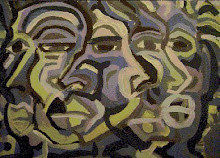 In 1998 - Si Ri Pak was the only Korean on the LPGA tour.
In 1998 - Si Ri Pak was the only Korean on the LPGA tour. Of the top-ten finishers (including ties - 16 players) in this weekend's Open Championship, 10 were from Asia.
Of the top-ten finishers (including ties - 16 players) in this weekend's Open Championship, 10 were from Asia.In the decade since Ms Pak's win, there are now 45 Korean women on tour.
The largest revenue source for the LPGA is it's television contract with Korea.
All this in spite of the LPGA's recent racist efforts to limit the number of Korean players participating on tour by (unsuccessfully) requiring their participants to speak English.
The Koreans didn't complain about the racism of the sport's governing body.
The Koreans didn't complain about those who became successful also becoming too bougie.
The Korean women just changed the complexion of the sport by dominating the LPGA.















2 comments:
Come on mang. You've put a little too much spin on this post. The Koreans have been dominating the women's tour for many years now, even before the LPGA attempted to overtly sanction its racism with the language requirement, which was wrong. Your suggestion that the Koreans, suddenly faced with the obstacle of racism, rose up and with quiet determination used the racism to motivate them to conquer and dominate the sport is misleading. They already owned the Women's tour. It was their domination that, I believe, was the impetus, in part, for attempting the English language measure. And there was hella uproar when this was attempted and a lot of Koreans did complain, however, as you suggest, they were much more subdued about it. I think this was so because they realized, as did all constituencies of the LPGA, that it is in the best interest of the organization economically, fan-wise, marketing-wise and sponsorship-wise that they learn to speak English. The Korean tv licensing deal is not the largest source of revenue for the LPGA, but the largest single source of revenue (i.e. the largest single revenue contract), but this $3-$4 mil contract is probably less the 6% of the LPGA's total revenue, its just the largest single source (I noticed a lot of stories that picked up the original story implied the same thing about the Korean tv revnue). Up until recently, the LPGA did not have a traditional tv licensing deal in the US, which accounts for the Korean deal being the largest single deal, but make no mistake, the US market is the primary driver of the LPGA and it's total revenues dwarf the Korean deal, hence, why it is in the Koreans' best interest to learn English. They need to be able to smooze with sponsors and partners, rep their products, relate to the fans, endear themselves to the primary American audience, etc. if the league is to remain appealing to the American audience, currently the principal driver of the LPGA.
The Asian folks as a whole clearly have a special affinity for the game of golf, naturally, some are going to do very well.
Lastly, I was watching when this chick won the open, and as a casual fan of the game, frankly I was put off that she couldn't articulate herself in English. It's difficult to get any sense of the personality through an interpreter and I wanted to get some sense of this athlete that had just won the highest prize in women's golf.
On a different racial aspect of the Korean domination of women's golf, it has the potential of alienating the primary US audience. The Korean female golfers seem to be rather stoic, unemotional, extremely subdued, personality-wise, which is only compounded if they can't speak English. Of course successful sports marketing in the US is largely personality driven. If the audience cannot get to know, relate to, or identify with the player, a huge amount of the appeal is lost. The parallel to the influx of Koreans in women's golf in American society is many of the Asian communities, at least in Southern California. Many of these communities have a very insular existence, essentially establishing their own little countries within the borders of the US. All the signage, menus, etc. in the language of their native countries, no appearance of attempting to potentially accommodate English speaking patrons, etc. Virtually no attempt at assimilating in greater mainstream America. Of course, it is their right to live how they please, but this has engendered resentment and disfavor with other Southern Cal populations, as these Asian communities seem more than willing to avail themselves of certain aspects of America, but show little desire to assimilate into the larger mainstream of America - and by assimilate, I don't mean full assimilation to the extent of erasing their own culture, but to be significantly integrated into greater American society beyond availing themselves of the benefits yet still being isolated. I think the Korean golfers risk the very same thing. Willing to come take the American prize money but not really integrate into the American sports culture in a way that is appealing the fan base that makes it all possible. Okay, much of this is not really on point, but I had time on my hands. I'm done.
Post a Comment